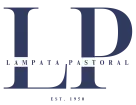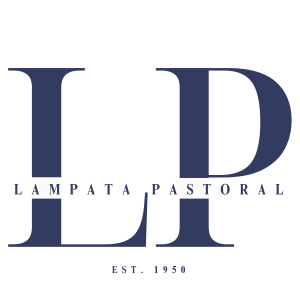The Hunt family are successful farmers running Nalang Farm, a 1200 hectare property in a 400 to 450mm climate 10km south of Bordertown in the upper south east of South Australia. On soils that range from heavy black cracking clay to red/brown loams, they operate a 70/30 cropping/sheep enterprise mix, growing a wide range of crops from canola, cereals and legumes in a set seven year rotation. The pasture mix base is sub clovers and ryegrass, while fodder reserves are chopped silage from one 30 hectare paddock each year. Their sheep enterprise comprises 1300 Merino base ewes in a self-replacing flock. For the last four years Bill and Ben Hunt have purchased their rams from Lampata, but there was a background journey worth outlining before they came to this decision.
With their self-replacing flock, the Hunts have a focus on improving their total sheep productivity and profitability levels, including fertility, wool and carcase returns.
“Our ideal objective is to have a flock that cuts an average of 4 to 5kg of wool, achieves a 45 to 47% carcase yield on sale lambs, and ewes that mature around 80kg bodyweight; sheep with productive efficiency combined with manageable maintenance costs,” Ben Hunt said.
Their sheep program is entwined with their cropping program. The ewes are mated for 6 weeks from Feb14th. Two top rams are put in with each mob of 270 to 300 ewes for the first three weeks, then 3 more are added for the last 3 weeks.
“This ensures we gain maximum benefit from our top rams and we are finding 70% of our lamb drop is being conceived in those first three weeks,” Ben said.
Thus lambing commences from the end of June to mid-August, with lamb marking in the fourth week of August.
“Our 10 year lamb weaning average is 106%, but with the great feed boost last year, followed by an April opening and clover now over 150mm in July, that percentage has been pushed up to around 140% this year,” Ben said.
Shearing is undertaken from mid-October, allowing the Hunts to market surplus ewes in the southern off-shears sales in late spring. Ben said their regular buyers are looking for big, plain bodied easy care ewes to produce first cross ewes for the prime lamb industry. With the huge and thick crops from last year’s good season, harvest did not finish until February.
“But that is not normal, not that there is such a thing as a normal year, especially with the last two years following on from two sub 250mm years before that,” Ben said.
Ben explained the male portion of the lamb drop is finished on the stubbles with silage supplement if needed and they excel, especially on the bean crop stubbles, targeting export weight lambs, mainly through JBS.
“We will forward contract if the price is right, but generally we can finish the lambs successfully for sale on the hooks from the middle of February, with the need for all to be gone by Anzac Day when we need the paddocks for the next cropping rotation.”
“Lambs are in relative short supply at that time of the year and while we might achieve 20 to 30cents/kg less than premium second cross lambs, the carcase quality of the Lampata progeny is high and they hang up exceptionally well,” he added.
The journey to get the carcase/wool productive balance on target with their objective has taken the Hunts down several different avenues before discovering Lampata genetics.
“We used SAMMs for 10 years. This got our frame and carcase quality up, but after a second cross, wool cut dropped to 3kg/hd.”
“We then tried traditional Merinos again from high profile studs and while wool cut increased, the carcase side of the program suffered greatly. Dressing percentages dropped down to below 40% and maternal attributes fell right off. Our lamb marking contractor also muscle scanned and this clearly demonstrated a dramatic fall off in muscling.”
“We also tried Dohnes and while their mature 600 day weight was okay, they were far too slow in growth in the first 100 to 300 days which is where we need it,” Ben said.
Thus the Hunts continued their search for more economical sheep with good muscle and that search took them to Lampata’s door, with totally paddock run sheep and over five decades of objective measurement behind them.
“What the Pococks said the sheep would do is exactly what we got. With no pampering when you saw the rams months after we purchased them they looked just as good or better,” Ben said.
“There is no ‘bullshit’ with Lampata. They show us everything on the background and performance levels of not only their rams, but their whole flock.”
“They have a high quality offering with heaps of numbers for selection pressure and there would be no more honest sheep on the market.”
“We are getting much faster 100 and 200 day weights, much stronger maternal traits and lamb carcase yields right up in the high forties again, plus wool cuts are now up around 4.5kg to 5kg. These sheep are doing the job very well.”
“I really respect the opinion of recently retired stock agent Peter DeGaris who once gave me advice I’ve never forgotten, that ‘there is always a market for quality sheep.’ For him to recently say we now have good sheep is a big compliment for me,” Ben said.
“Lampata rams are good honest sheep that perform even in harsh conditions. Their figures are totally trustworthy. What you see is what you get and we like what we see,” Ben concluded.

